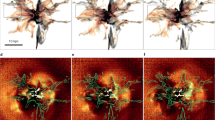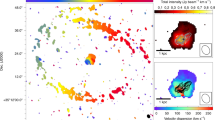Abstract
Gas accretion by a galaxy’s central supermassive black hole (SMBH) and the resultant energetic feedback by the accreting active galactic nucleus (AGN) on the gas in and around a galaxy are two tightly intertwined but competing processes that play a crucial role in the evolution of galaxies. Observations of galaxy clusters have shown how the plasma jets emitted by an AGN heat the intracluster medium, preventing cooling of the cluster gas and thereby the infall of this gas onto the central galaxy. On the other hand, outflows of multiphase gas, driven by the jets, can cool as they rise into the intracluster medium, leading to filaments of colder gas. The fate of this cold gas is unclear, but it has been suggested that it plays a role in feeding the central SMBH. We present the results of reprocessed CO(2-1) Atacama Large Millimeter/submillimeter Array observations of the cold molecular gas in the central regions of NGC 1275, the central galaxy of the Perseus cluster and which hosts the radio-loud AGN 3C 84 (Perseus A). These data show in detail how kiloparsec-sized cold gas filaments resulting from the jet-induced cooling of cluster gas are flowing towards the galaxy centre and how they feed the circum-nuclear accretion disk (100 pc diameter) of the SMBH. Thus, cooled gas can, in this way, play a role in feeding the AGN. These results complete our view of the feedback loop of how an AGN can impact its surroundings and how the effects of this impact maintain the AGN activity.
This is a preview of subscription content, access via your institution
Access options
Access Nature and 54 other Nature Portfolio journals
Get Nature+, our best-value online-access subscription
$29.99 / 30 days
cancel any time
Subscribe to this journal
Receive 12 digital issues and online access to articles
$119.00 per year
only $9.92 per issue
Buy this article
- Purchase on Springer Link
- Instant access to full article PDF
Prices may be subject to local taxes which are calculated during checkout






Similar content being viewed by others
Data availability
The calibrated data cube is available from https://astrodrive.astro.rug.nl/index.php/s/g1y6QlCeGFd5XiG, or from the corresponding author on reasonable request.
References
Russell, H. R. et al. Driving massive molecular gas flows in central cluster galaxies with AGN feedback. Mon. Not. R. Astron. Soc. 490, 3025–3045 (2019).
Fabian, A. C. et al. A wide Chandra view of the core of the Perseus cluster. Mon. Not. R. Astron. Soc. 418, 2154–2164 (2011).
Pedlar, A. et al. The radio structure of NGC 1275. Mon. Not. R. Astron. Soc. 246, 477 (1990).
Minkowski, R. Optical investigations of radio sources (introductory lecture). In Proc. Symposium of the International Astronomical Union, Vol. 4 (ed. van de Hulst, H. C.) 107–122 (Cambridge Univ. Press, 1957).
Conselice, C. J., Gallagher, I., John, S. & Wyse, R. F. G. On the nature of the NGC 1275 system. Astron. J. 122, 2281–2300 (2001).
Fabian, A. C. et al. Magnetic support of the optical emission line filaments in NGC 1275. Nature 454, 968–970 (2008).
Gendron-Marsolais, M. et al. Revealing the velocity structure of the filamentary nebula in NGC 1275 in its entirety. Mon. Not. R. Astron. Soc. 479, L28–L33 (2018).
Hatch, N. A., Crawford, C. S., Fabian, A. C. & Johnstone, R. M. Detections of molecular hydrogen in the outer filaments of NGC1275. Mon. Not. R. Astron. Soc. 358, 765–773 (2005).
Lim, J., Ohyama, Y., Yan, C.-H., Ding-V-Trung, & Wang, S.-Y. A molecular hydrogen nebula in the central cD galaxy of the Perseus cluster. Astrophys. J. 744, 112 (2012).
Salomé, P. et al. Cold molecular gas in the Perseus cluster core. Association with X-ray cavity, Hα filaments and cooling flow. Astron. Astrophys. 454, 437–445 (2006).
Lim, J., Ao, Y. & Ding-V-Trung, Radially inflowing molecular gas in NGC 1275 deposited by an X-ray cooling flow in the Perseus cluster. Astrophys. J. 672, 252–265 (2008).
Ho, I. T., Lim, J. & Ding-V-Trung, Multiple radial cool molecular filaments in NGC 1275. Astrophys. J. 698, 1191–1206 (2009).
Fabian, A. C. et al. The energy source of the filaments around the giant galaxy NGC 1275. Mon. Not. R. Astron. Soc. 417, 172–177 (2011).
Wilman, R. J., Edge, A. C. & Johnstone, R. M. The nature of the molecular gas system in the core of NGC 1275. Mon. Not. R. Astron. Soc. 359, 755–764 (2005).
Scharwächter, J., McGregor, P. J., Dopita, M. A. & Beck, T. L. Kinematics and excitation of the molecular hydrogen accretion disc in NGC 1275. Mon. Not. R. Astron. Soc. 429, 2315–2332 (2013).
Nagai, H. et al. The ALMA discovery of the rotating disk and fast outflow of cold molecular gas in NGC 1275. Astrophys. J. 883, 193 (2019).
Salomé, P. et al. Observations of CO in the eastern filaments of NGC 1275. Astron. Astrophys. 483, 793–799 (2008).
Salomé, P. et al. A very extended molecular web around NGC 1275. Astron. Astrophys. 531, A85 (2011).
Fabian, A. C. et al. Do sound waves transport the AGN energy in the Perseus cluster? Mon. Not. R. Astron. Soc. 464, L1–L5 (2017).
Churazov, E., Sunyaev, R., Forman, W. & Böhringer, H. Cooling flows as a calorimeter of active galactic nucleus mechanical power. Mon. Not. R. Astron. Soc. 332, 729–734 (2002).
Hatch, N. A., Crawford, C. S., Johnstone, R. M. & Fabian, A. C. On the origin and excitation of the extended nebula surrounding NGC1275. Mon. Not. R. Astron. Soc. 367, 433–448 (2006).
Qiu, Y., Bogdanović, T., Li, Y., McDonald, M. & McNamara, B. R. The formation of dusty cold gas filaments from galaxy cluster simulations. Nat. Astron. 4, 900–906 (2020).
Gaspari, M., Temi, P. & Brighenti, F. Raining on black holes and massive galaxies: the top-down multiphase condensation model. Mon. Not. R. Astron. Soc. 466, 677–704 (2017).
Bolatto, A. D., Wolfire, M. & Leroy, A. K. The CO-to-H2 conversion factor. Ann. Rev. Astron. Astrophys. 51, 207–268 (2013).
Bregman, J. N., Fabian, A. C., Miller, E. D. & Irwin, J. A. On VI observations of galaxy clusters: evidence for modest cooling flows. Astrophys. J. 642, 746–751 (2006).
Holtzman, J. A. et al. Planetary camera observations of NGC 1275: discovery of a central population of compact massive blue star clusters. Astron. J. 103, 691 (1992).
Lim, J., Wong, E., Ohyama, Y. & Yeung, M. C. H. Recent formation of a spiral disk hosting progenitor globular clusters at the center of the Perseus brightest cluster galaxy. II. Progenitor globular clusters. Astrophys. J. 927, 138 (2022).
Nagai, H. et al. VLBI Monitoring of 3C 84 (NGC 1275) in early phase of the 2005 outburst. Publ. Astron. Soc. Jpn 62, L11 (2010).
Kino, M. et al. Morphological transition of the compact radio lobe in 3C 84 via the strong jet–cloud collision. Astrophys. J. Lett. 920, L24 (2021).
Hogan, M. T. et al. A comprehensive study of the radio properties of brightest cluster galaxies. Mon. Not. R. Astron. Soc. 453, 1201–1222 (2015).
O’Dea, C. P., Dent, W. A. & Balonek, T. J. The 20 year spectral evolution of the radio nucleus of NGC 1275. Astrophys. J. 278, 89–95 (1984).
Dutson, K. L. et al. A non-thermal study of the brightest cluster galaxy NGC 1275 – the gamma-radio connection over four decades. Mon. Not. R. Astron. Soc. 442, 2048–2057 (2014).
Paraschos, G. F. et al. A multi-band study and exploration of the radio wave-γ-ray connection in 3C 84. Astron. Astrophys. 669, A32 (2023).
Sault, R. J., Teuben, P. J. & Wright, M. C. H. A retrospective view of MIRIAD. ASP Conf. Ser. 77, 433–436.
Westmeier, T. et al. SOFIA 2 – an automated, parallel H i source finding pipeline for the WALLABY survey. Mon. Not. R. Astron. Soc. 506, 3962–3976 (2021).
Lim, J., Dinh-V-Trung, Vrtilek, J., David, L. P. & Forman, W. The role of electron excitation and nature of molecular gas in cluster central elliptical galaxies. Astrophys. J. 850, 31 (2017).
Acknowledgements
This work is based on reprocessing of the ALMA observations carried out under project number 2017.0.01257.S and which were published in original form by Nagai et al.16.
Author information
Authors and Affiliations
Contributions
T.O. and R.M. conceived the project. T.O. reduced the data. T.O., R.M. and S.M. carried out the analysis and wrote the manuscript. All authors discussed the results and commented on the manuscript.
Corresponding author
Ethics declarations
Competing interests
The authors declare no competing interests.
Peer review
Peer review information
Nature Astronomy thanks Alastair Edge and Jeremy Lim for their contribution to the peer review of this work.
Additional information
Publisher’s note Springer Nature remains neutral with regard to jurisdictional claims in published maps and institutional affiliations.
Rights and permissions
Springer Nature or its licensor (e.g. a society or other partner) holds exclusive rights to this article under a publishing agreement with the author(s) or other rightsholder(s); author self-archiving of the accepted manuscript version of this article is solely governed by the terms of such publishing agreement and applicable law.
About this article
Cite this article
Oosterloo, T., Morganti, R. & Murthy, S. Closing the feedback-feeding loop of the radio galaxy 3C 84. Nat Astron 8, 256–262 (2024). https://doi.org/10.1038/s41550-023-02138-y
Received:
Accepted:
Published:
Issue Date:
DOI: https://doi.org/10.1038/s41550-023-02138-y



